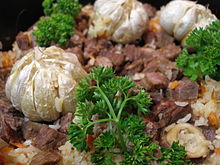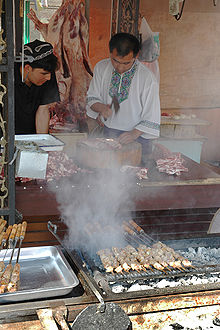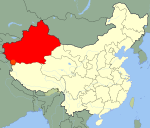- Xinjiang cuisine
-

This article is part of the series Chinese cuisine Regional cuisinesFour Great Traditions
Cantonese • Huaiyang • Shandong • Sichuan
Eight Great Traditions
Anhui • Cantonese • Fujian • Hunan • Jiangsu • Shandong • Sichuan • ZhejiangBeijing and the vicinity
Beijing • Imperial • Aristocrat • TianjinOther regional styles
Chaozhou • Guizhou • Hainan • Hakka • Henan • Hong Kong • Hubei • Jiangxi • Macanese • Manchu • Northeastern • Shaanxi • Shanghai • Shanxi • Taiwanese • Xinjiang • Tibetan (Xizang) • YunnanReligious cuisinesBuddhist • IslamicIngredients and types of food China portal
China portalXinjiang cuisine (Chinese: 新疆菜) reflects the region's many ethnic groups, and refers particularly to Uyghur cuisine (Uyghur: ئۇيغۇرچە يەمەكلىرى, ULY: Uyghurche yemekliri). Signature ingredients include roast mutton, kebabs, roast fish and rice.[1] Because of the Islamic population, the food is predominantly halal.
Xinjiang cuisine is found throughout much of China, as migrants from the region often open Xinjiang restaurants or food stands in other regions.
Contents
Ethnic composition
Ethnic groups in Xinjiang generally have different cooking and eating methods. Han people in Xinjiang use chopsticks while Kazakhs eat with their hands. Ceremonial foods for certain groups include horse milk for the Kyrgyz and sheep entrails for the Xibe.[2] The dishes of the Dongxiang people are prominent in Xinjiang-style restaurants. Signature Dongxiang dishes are noodles boiled in thick mutton soup and steamed twisted rolls.[3]
Uyghur food
Uyghur pilaf (پولۇ)
Uyghur food (Uyghur Yemekliri) is characterized by mutton, beef, camel, chicken, goose, carrots, tomatoes, onions, peppers, eggplant, celery, various dairy foods, and fruits.
Uyghur-style breakfast is tea with home-baked bread, hardened yogurt, olives, honey, raisins, and almonds. Uyghurs like to treat guests with tea, naan and fruit before the main dishes are ready.
Sangza (Uyghur: ساڭزا) are crispy and tasty fried wheat flour dough twists, a holiday specialty. Samsa (Uyghur: سامسا) are lamb pies baked using a special brick oven. Youtazi is steamed multilayer bread. Göshnan (Uyghur: گۆشنان) are pan-grilled lamb pies. Pamirdin are baked pies with lamb, carrots, and onion inside. Xurpa is lamb soup (Uyghur: شۇرپا). Other dishes include Tohax, a different type of baked bread, and Tunurkawab.
Primary dishes
The primary dishes include Shou La Mian (Uyghur: لەڭمەن), Shou La Mian is a special type of handmade noodle, made from flour, water and salt. The dough is divided into small balls and then stretched by hand. The noodles are boiled until very soft and then served topped with stir-fried meat, vegetables (bell peppers, hot peppers, cabbage, onion, tomatoes), in meat stock.
Other dishes include soups made of lamb or chicken; shish kebabs of lamb or beef; and polos (Uyghur: پولۇ) (rice platters also known as pilaf or plov, with lamb or chicken). Bread is the Central Asian-style baked flatbread known as naan (Uyghur: نان), using sesame seeds, butter, milk, vegetable oil, salt, and sugar.
Kebabs, seasoned with chili powder, salt, black pepper, and ziran (cumin), are eaten with the skewer parallel to the mouth, gripping the kebab closest to the end with one's teeth and sliding it off the pointed edge into one's mouth.
Another popular Xinjiang dish is Da Pan Ji (大盘鸡), which is literally translated as 'Big Plate Chicken'.
Spices
Spices include cumin seeds, red pepper flakes, salt and pepper, sultanas, and the fat of the meat is used for flavoring.
Beverages
Beverages include Chinese black tea, Kvass (a honeyed nonalcoholic drink), and other drinks available in other areas of China (bottled).
See also
References
- ^ "Xinjiang Cuisine". All-China Women's Federation. 2006-04-10. http://www.womenofchina.cn/quintessential_china/food/cuisine/3161.jsp. Retrieved 2010-11-24.
- ^ Dana, Leo-Paul, ed (2010). Entrepreneurship and Religion. Edward Elgar Publishing. pp. 287–288. ISBN 9781847205728.
- ^ Zhuang, Kongshao (2002). "The Development of Ethnic Cuisine in Beijing". In Cheung, Sidney C.H.. The Globalization of Chinese Food. University of Hawaii Press. pp. 75–77. ISBN 9780824825829.
External links
Xinjiang Uyghur Autonomous Region county-level divisions Ürümqi: Tianshan District · Saybagh District · Xinshi District · Shuimogou District · Toutunhe District · Dabancheng District · Midong District · Ürümqi County
Ili: Yining City · Kuytun City · Yining County · Huocheng County · Tokkuztara County · Künes County · Zhaosu County · Tekes County · Nilka County · Qapqal Autonomous County
Tacheng1: Tacheng City · Wusu City · Emin County · Yumin County · Shawan County · Toli County · Hoboksar Autonomous County
Altay1: Altay City · Qinggil County · Jeminay County · Fuyun County · Burqin County · Fuhai County · Habahe CountyKaramay: Karamay District · Dushanzi District · Baijiantan District · Urho District
Turpan: Turpan City · Toksun County · Piqan County
Kumul: Kumul City · Yiwu County · Barkol Autonomous County
Hotan2: Hotan City · Hotan County · Lop County · Minfeng County · Pishan County · Qira County · Keriya County · Karakax County
Aksu: Aksu City · Wensu County · Xayar County · Baicheng County · Awat County · Kuqa County · Kalpin County · Toksu County · Uqturpan County
Kashgar: Kashgar City · Maralbishi County · Poskam County · Peyziwat County · Kargilik County · Yopurga County · Shule County · Mekit County
Yengisar County · Yarkent County · Shufu County · Tashkurgan Autonomous CountyKizilsu: Artux City · Akqi County · Ulugqat County · Akto County
Bayin'gholin: Korla City · Hejing County · Yuli County · Hoxud County · Qiemo County · Bohu County · Luntai County · Ruoqiang County
Yanqi Autonomous CountyBortala: Bortala City · Jinghe County · Wenquan County
Changji: Changji · Fukang · Qitai County · Manas County · Jimsar County · Hutubi County · Mori Autonomous County
Shihezi: (no intermediate County-level divisions, see Administration of Shihezi)
Aral: (no intermediate County-level divisions, see Administration of Aral)
Tumxuk: (no intermediate County-level divisions, see Administration of Tumxuk)
Wujiaqu: (no intermediate County-level divisions, see Administration of Wujiaqu)■ = Sub-provincial autonomous prefecture ■ = Prefecture-level city ■ = Prefecture ■ = Autonomous prefectures ■ = Sub-prefecture-level city of the Xinjiang Production and Construction Corps
2 Aksai Chin is administered by the PRC as part of Hotan, but claimed by India.
1 Tacheng and Altay are prefectures within and under the administration of the Ili Kazakh Autonomous Prefecture.Xinjiang topics General Geography Cities • Tian Shan • Dzungarian Basin • Tarim Basin • Gurbantünggüt Desert • Kumtag Desert • Taklimakan Desert • Turpan Depression • Karakoram Mountains • Altai Mountains • Tian Shan • Kunlun Shan • Pamir Mountains • Torugart Pass • Karakoram PassEducation Culture Cuisine Dapanji • Sangza • Samsa • Youtazi • Pamirdin • Xurpa • Tohax • Tunurkawab • Chinese Islamic cuisineVisitor attractions Apak Khoja and Xiang Fei Tomb • Flaming Mountains • Jiaohe Ruins • Gaochang • Grand Bazaar, Ürümqi • Id Kah Mosque • Karakul Lake • Kizil Caves • Ruins of NiyaCategories:- Xinjiang
- Uyghur cuisine
- Central Asian cuisine
- Regional cuisines of China
- Chinese cuisine stubs
Wikimedia Foundation. 2010.



